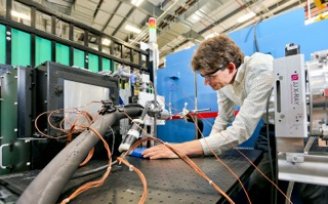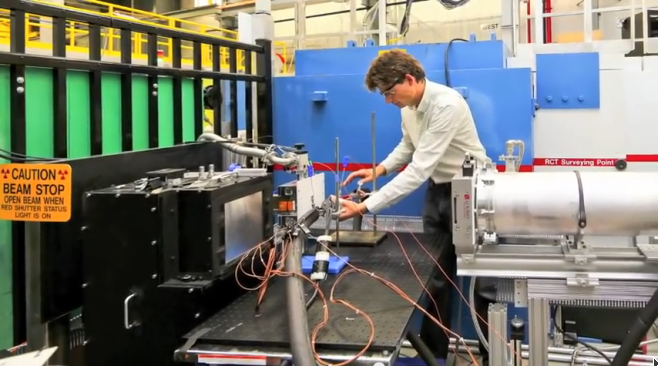Copyright 2012 neutronsources.org | All rights reserved. | Powered by FRM II | Imprint / Privacy Policy
Unprecedented neutron images of refrigerant flow through heat exchangers
Date: 10/03/2015
Source: http://phys.org/news/

Researchers at the Department of Energy’s Oak Ridge National Laboratory have captured undistorted snapshots of refrigerants flowing through small heat exchangers, helping to further elucidate characteristics of heat transfer.
The researchers used additive manufacturing and neutron imaging capabilities to examine microchannel heat exchangers, which hold refrigerants used to move thermal energy and provide cooling or heating in many applications. The noninvasive techniques allowed the researchers to visualize how refrigerants reacted to different temperature levels without disrupting the refrigerant flow.
“That’s what we’re trying to understand—what does the refrigerant look like on the inside of these channels?” said Patrick Geoghegan, a researcher with the Buildings Technologies Research and Integration Center. “Then you can understand how the heat transfer is actually taking place.”
The goal with microchannel heat exchangers is to improve overall heat transfer, which could potentially reduce the temperature difference between the air and a refrigerant in a heating, cooling and ventilation system, resulting in energy savings because the unit’s compressor does not need to work as hard to move refrigerant from the evaporator to the condenser. Additionally, the heat exchangers minimize airside pressure drop, which results in more energy savings gained from the fan energy consumption.
Past research has focused on refrigerant heat exchange, but the ORNL team is the first to make use of neutron imaging in microchannel studies.
Previously, the usual mode of operation was to cut off the top of a larger heat exchanger tube, cover it with Plexiglas and then peer inside as it was heated, a method Geoghegan said could lead to inaccurate results.
With the issue in mind, the ORNL team turned to microchannels and partnered with 3D printing company Fabrisonic to specifically design them for neutron imaging. Additive manufacturing kept the microchannels small and compact, eliminating the need for extra material and refrigerant, and provided a cost-effective and environmentally friendly approach to the research.
“Additive manufacturing helped achieve the best experimental conditions,” Geoghegan said, adding, “The microchannel heat exchangers use very little material and refrigerant and that’s great for minimizing the global warming potential.”
To observe the effects of heat on microchannels, the researchers ran refrigerant through the microchannels and subjected them to increasing amounts of heat over five days. At a number of cool-, medium- and high-heat stages, the team used neutrons from ORNL’s High Flux Isotope Reactor—a DOE Office of Science User Facility—to take images of the refrigerant while it was in the microchannel.
The microchannels rested horizontally, and the expected outcome was that gravity would cause the liquid portion of the refrigerant liquid/vapor mixture to sink to the bottom of the microchannel, leaving less area for heat transfer.
Instead, the images showed that surface tension properties of the microchannels caused the refrigerant liquid to stick to all sides of the microchannel, maximizing the amount of area available for heat transfer. Only at elevated temperatures was the refrigerant liquid forced to the center by vapor and no longer able to absorb and take heat away from the microchannel walls at a rapid rate.
“The beauty with microchannels is that surface tension comes into play, and surface tension holds the refrigerant liquid onto all the surfaces of the microchannel,” Geoghegan said. “That’s why you see equal refrigerant liquid on the top and bottom surfaces.
“The entire area is still available for heat transfer and that’s what you want,” he said.
With the additive manufacturing, neutron imaging and microchannels work, the team is just heating up. Geoghegan also expects to publish a journal article and continue experimenting with the ability of refrigerants in small microchannels to work efficiently in high heat by keeping all surfaces wetted with liquid until the evaporation process is completed and no more liquid remains.
Explore further: New ORNL-GE Appliances project aims to revolutionize residential refrigerators
Provided by: Oak Ridge National Laboratory
